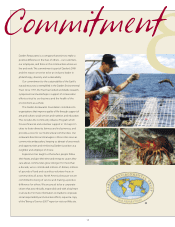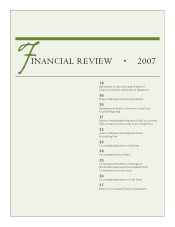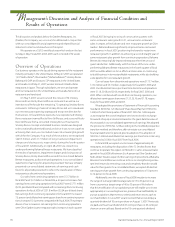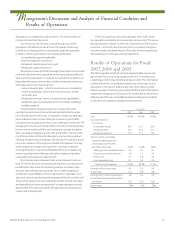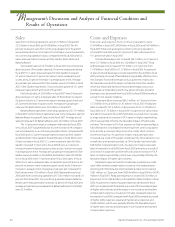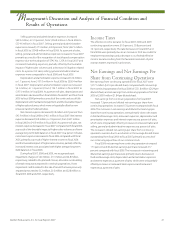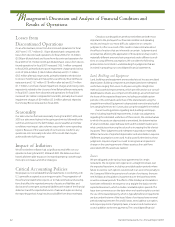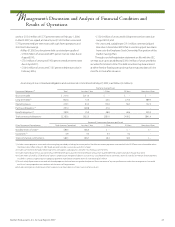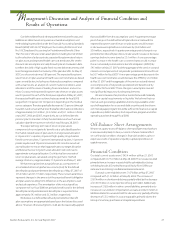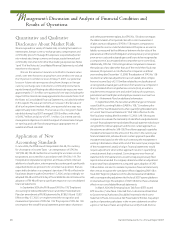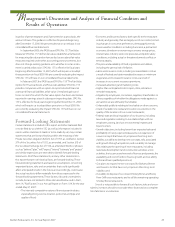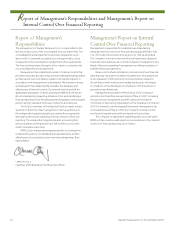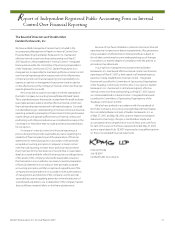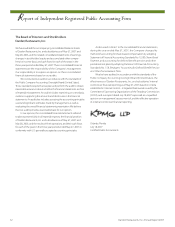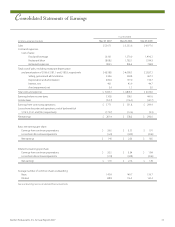Red Lobster 2007 Annual Report Download - page 25
Download and view the complete annual report
Please find page 25 of the 2007 Red Lobster annual report below. You can navigate through the pages in the report by either clicking on the pages listed below, or by using the keyword search tool below to find specific information within the annual report.
M
Darden Restaurants, Inc. Annual Report 2007 23
Management’s Discussion and Analysis of Financial Condition and
Results of Operations
statements reflect the same lease term for amortizing leasehold
improvements as we use to determine capital versus operating lease
classifications and in calculating straight-line rent expense for each
restaurant. Percentage rent expense is generally based on sales levels
and is accrued when we determine that it is probable that those sales
levels will be achieved.
Our judgments related to the expected term for each leased
restaurant property affect the classification and accounting for
leases as capital versus operating, the rent holidays and escalation
in payments that are included in the calculation of straight-line rent
and the term over which leasehold improvements for each restaurant
are amortized. These judgments may produce materially different
amounts of depreciation, amortization and rent expense than would
be reported if different assumed lease terms were used.
Impairment of Long-Lived Assets
Land, buildings and equipment and certain other assets, including
capitalized software costs and liquor licenses, are reviewed for impair-
ment whenever events or changes in circumstances indicate that the
carrying amount of an asset may not be recoverable. Recoverability of
assets to be held and used is measured by a comparison of the carry-
ing amount of the assets to the future undiscounted net cash flows
expected to be generated by the assets. Identifiable cash flows are
measured at the lowest level for which they are largely independent
of the cash flows of other groups of assets and liabilities, generally at
the restaurant level. If these assets are determined to be impaired,
the amount of impairment recognized is the amount by which the
carrying amount of the assets exceeds their fair value. Fair value is
generally determined by appraisals or sales prices of comparable
assets. Restaurant sites and certain other assets to be disposed of
are reported at the lower of their carrying amount or fair value, less
estimated costs to sell. Restaurant sites and certain other assets to be
disposed of are included in assets held for sale when certain criteria
are met. These criteria include the requirement that the likelihood of
disposing of these assets within one year is probable. For assets that
meet the held for sale criteria, we separately evaluate whether those
assets also meet the requirements to be reported as discontinued
operations. Principally, if we discontinue cash flows and no longer
have any significant continuing involvement with respect to the
operations of the assets, we classify the assets and related results of
operations as discontinued. We consider guest transfer (an increase
in guests at another location as a result of the closure of a location)
as continuing cash flows and evaluate the significance of expected
guest transfer when evaluating a restaurant for discontinued opera-
tions reporting. To the extent we dispose of enough assets where
classification between continuing operations and discontinued
operations would be material to our consolidated financial
statements, we utilize the reporting provisions for discontinued
operations. Assets whose disposal is not probable within one year
remain in land, buildings and equipment until their disposal is
probable within one year.
The judgments we make related to the expected useful lives of
long-lived assets and our ability to realize undiscounted cash flows in
excess of the carrying amounts of these assets are affected by factors
such as the ongoing maintenance and improvements of the assets,
changes in economic conditions, changes in usage or operating
performance, desirability of the restaurant sites and other factors, such
as our ability to sell our assets held for sale, as in the case of Smokey
Bones. As we assess the ongoing expected cash flows and carrying
amounts of our long-lived assets, significant adverse changes in
these factors could cause us to realize a material impairment charge.
During fiscal 2007, we recognized impairment charges of $236.4
million ($146.0 million after tax), primarily related to the decision to
close or hold for sale all Smokey Bones and Rocky River Grillhouse
restaurants, and we recognized impairment charges of $12.7 million
($7.8 million after tax) related to the decision to permanently close
nine Bahama Breeze restaurants. The impairment charges were
based on a comparison of the net book value and the estimated
fair value of the restaurants. These charges are included in losses
from discontinued operations, net of tax on our consolidated
statements of earnings. We also recognized $2.4 million ($1.5 million
after tax) of impairment charges, included in asset impairment,
net on our consolidated statements of earnings, primarily related to
the permanent closing of one Red Lobster and one Olive Garden in
fiscal 2007. During fiscal 2006, we recognized impairment charges
of $8.4 million ($5.2 million after tax), related to the closing of three
Smokey Bones restaurants and the impairment of two other Smokey
Bones restaurants based on an evaluation of expected cash flows.
These charges are included in losses from discontinued operations,
net of tax on our consolidated statements of earnings. During fiscal
2006, we also recorded charges of $1.3 million ($0.8 million after tax),
included in asset impairment, net on our consolidated statements
of earnings, primarily related to the closing of three Red Lobster and
two Olive Garden restaurants. During fiscal 2005, we recognized asset
impairment charges of $2.5 million ($1.5 million after tax) related to
one Smokey Bones restaurant based on an evaluation of expected
cash flows. These charges are included in losses from discontinued
operations, net of tax on our consolidated statements of earnings.
During fiscal 2005 we also recorded charges of $4.8 million ($3.0 million
after tax), included in asset impairment, net on our consolidated state-
ments of earnings, for the write-down of two Olive Garden restaurants
and one Red Lobster restaurant based on an evaluation of expected
cash flows. These charges were partially offset by $2.8 million of gains
related to the sale of previously impaired assets.
Insurance Accruals
Through the use of insurance program deductibles and self-insurance,
we retain a significant portion of expected losses under our workers’
compensation, employee medical and general liability programs.
However, we carry insurance for individual workers’ compensation
and general liability claims that generally exceed $0.25 million.
Accrued liabilities have been recorded based on our estimates of the



